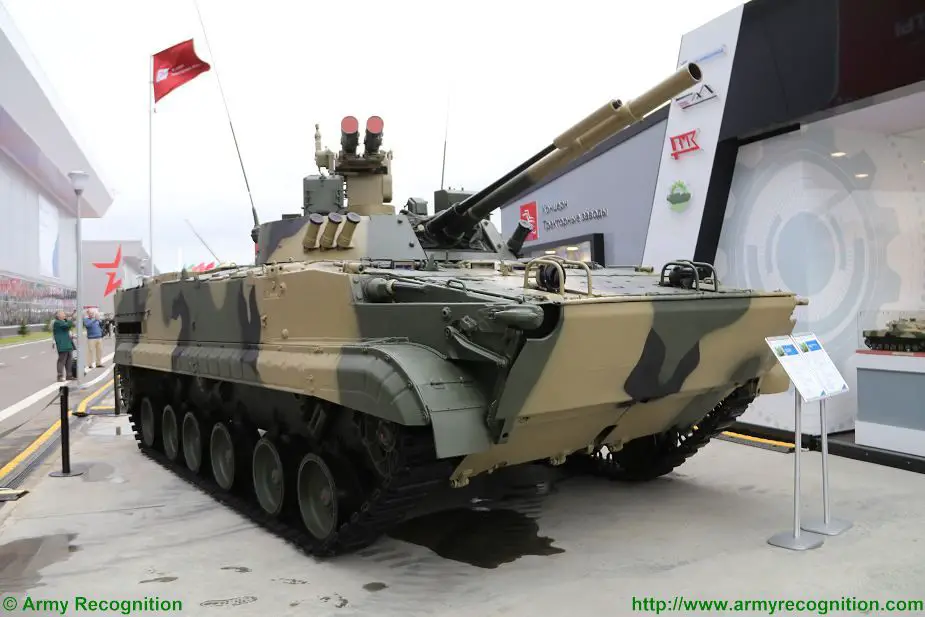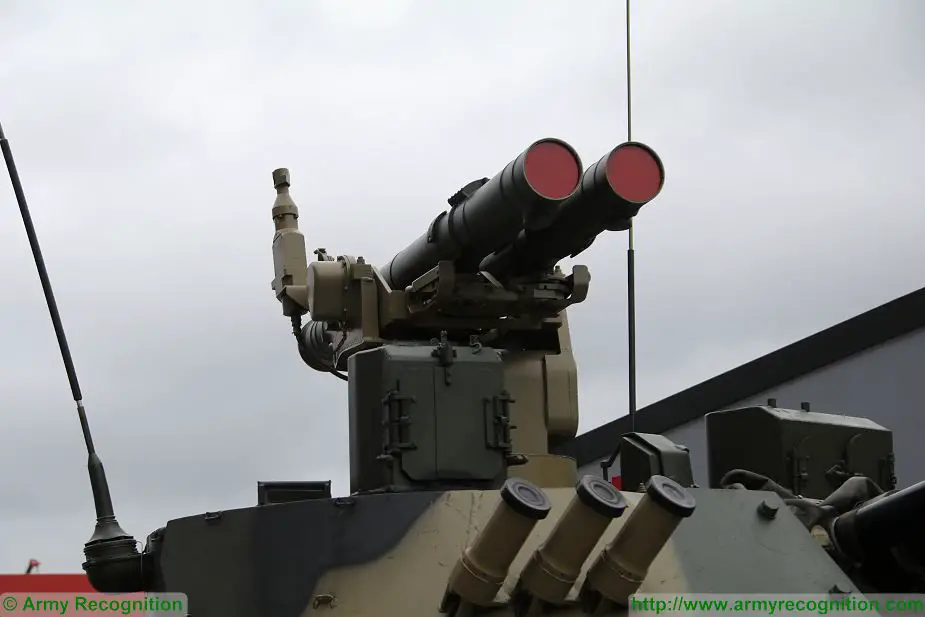Parallax controls the battle. The first "transparent armor" for robotics was created in Russia At the international forum Army-2020, the Signal Research Institute presented a number of robotic vehicles capable of changing the course of hostilities at a tactical level
At the international forum Army-2020, the Signal Research Institute presented a number of robotic vehicles capable of changing the course of hostilities at a tactical levelThe defense-industrial complex (DIC) of a number of countries is developing solutions aimed at maximizing the simplification of the actions of the Ground Forces units in battle. One of the current trends in the development of technology is its robotization, which makes it possible to automate the performance of a combat mission, increase the efficiency and coherence of actions, and also minimize the level of losses.
It is premature to talk about the dominance of robotics on the modern battlefield, but there are already examples that can have a significant impact on the development of the direction in the future. At the moment, one of the main trends is the creation of specialized samples and the conversion of existing machines. Russia, being one of the most developed developers and manufacturers of robots, is developing both of the above directions.
The domestic defense industry creates both combat robotics, for example, Uran-9, and multipurpose, in particular, the Uran-6 robotic demining system and the Uran-14 fire robot.
One of the key issues arising in the creation of high-tech weapons is their cost and, more importantly, the ratio of cost and effectiveness. It is the high cost of development that often limits the ability of various armies to massively deploy robots - at the moment, no army in the world is deploying combat robotics in large quantities. In this context, designing on the basis of existing machines can give impetus to the combat use of robotics.
The High-Precision Complexes holding (as part of the Rostec State Corporation) is one of the largest Russian developers of robotic systems, while the direct executor of work in this area is the Signal All-Russian Research Institute (JSC VNII Signal) The Institute is a Russian pioneer in the field of designing robots on the basis of existing technology We tell you about the novelties presented by the enterprise at the forum "Army-2020".
Parallax on the battlefield
The "Parallax" surveillance and targeting system operates on the principle of "transparent armor". It is installed on the chassis of the BMP-3 infantry fighting vehicle and turns it into a multifunctional combat robot, made with minimal modifications to the basic chassis model.
Denis Varabin, deputy general director and project manager of Signal, told TASS that the BMP-3 chassis was chosen to participate in a variety of work to explore the possibilities of robotization. "We have ensured the possibility of the machine functioning in remote and automatic modes, but at the same time the crew control method is preserved," he said.
According to him, the BMP-3, modernized within the framework of the Parallax program, is now capable of crossing water obstacles and firing afloat. “We robotic the basic functions of the sample. The vehicle can be equipped with different combat modules: the prototype, in particular, has a standard BMP-3 turret. We made it remote-controlled and equipped it with modern combat control technologies,” Varabin said. The combat module with "Parallax" is controlled using virtual reality glasses (virtual reality, VR).
The operator puts on glasses and operates [the tower] by turning the head. A small-sized joystick is responsible for fire control. Everything is comfortable and receptive for the modern generation - Denis Varabin Deputy General Director - Project Manager VNII "Signal" wrote:
The BMP-3, upgraded under the Parallax program, became the first Russian combat vehicle in which the principle of "transparent armor" is implemented (the operator, using various sensors, sees an integral and most realistic picture of the battle, but remains behind the armor or in cover). "There are no analogues of this technique in Russia," Varabin emphasized.
The machine has fully retained its standard capabilities - so, troops can be loaded into it, and if necessary, the operator can turn on the remote or automatic control mode. Outwardly, the robotic BMP-3 is practically indistinguishable from conventional BMPs of this type.
It has already implemented the function of automated route passage. The operator marks the points of passage on the map, after which the car begins to move along them. According to Varabin, work is currently underway on an autonomous control mode. "In this case, the operator sets the end point, after which the machine itself chooses the route and bends around obstacles, based on the sensor data," he clarifies.

The new robotic system is controlled at long distances using a wearable or remote control panel. The operator's workplace is at a distance, while he can see the status of the machine and its condition. The commander can control several vehicles on the battlefield. Also, the mode is standardly implemented when he can intercept control instead of the shooter in case of injury to the latter. “We are trying to reduce the number of machine control devices by optimizing them and bringing them together in one window,” added Varabin.
Thus, VNII "Signal" followed the path of robotizing an existing sample, rather than creating an absolutely new system. This approach, as noted above, is more economically efficient. Moreover, it allows the robotization of existing equipment during intermediate repairs.
Varabin stressed that the BMP-3 equipped with Parallax is a prototype - a technology demonstrator, which is used to test various technical solutions.
Different fighting compartments were installed on this sample - about five to six samples, which were robotized according to the same principle. We can also integrate the fighting squads of other developers. By and large, this is a set of technologies that, depending on specific requirements, can be integrated, as a rule, in a factory repair. - Denis Varabin Deputy General Director - Project Manager VNII "Signal"
The developers are considering the possibility of further intellectualizing the machine. "In our opinion, it is necessary to form a decision support system. This will reduce the crew of a combat vehicle from three people [commander, driver, operator-gunner] to one [commander]. By issuing instructions to the computer and combat module, BMPs are excluded from the work , respectively, the driver-mechanic and the gunner-operator. Only the commander remains, who serves as a source of decision-making, "Varabin said, adding that in the future, vehicles with Parallax will be able to receive the function of a programmable sequence of targets.
VNII "Signal" is also working to improve the virtual reality system, with which control is carried out. This will reduce the burden on the operator and increase the time to operate the machine.
One of the features of the "Parallax" complex is its modular design - the robotization kit includes several systems that do not impair the ergonomics of the machine and provide remote control. "We take this set of robotic equipment and install it on various mobile objects. It includes drives and electromechanics for controlling controls, electrical control systems for reading machine data and remote control, navigation system, power supply system, additional systems for video surveillance and control traffic, as well as a communication system, "- said Varabin.
"Passage" in a minefieldDuring the Army-2015 exhibition, the Signal VNII presented a remote-controlled demining machine called the Pass. It is developed on the basis of the BMR-3MA combat vehicle and is intended for the engineering troops.

Mikhail Kobyakin, head of the department for advanced development of the Signal All-Russian Research Institute, told TASS that the complex can neutralize all types of mines and simultaneously save the life of the crew. "The main task is to perform a combat mission while saving the life of the crew, since it is he who is primarily susceptible to a mine explosion. [When using the" Pass "] the operator, being at a distance, retains the technical ability to drive the car, while ensuring his complete safety." , - he said.
"Passage" is made on the chassis of the T-90 tank. As part of this work, a set of attachments has been created, which requires minimal modifications during installation. Trawls of various types act as the main anti-mine device.
This machine can be used with all types of trawls, both old and new. It neutralizes all types of mines, including those with contact and proximity fuses, and even anti-aircraft mines. "Pass" is also equipped with an electronic warfare (EW) complex, capable of suppressing the fuses of radio-controlled mines -Mikhail Kobyakin Head of the Department for Advanced Development, VNII "Signal"
The new machine is controlled over a long distance using an anti-jamming communication channel. "We worked through the impact of separate [electronic warfare] complexes - there is a connection in any case," Kobyakin said. The complex also provides for the possibility of passing the demining machine at pre-programmed points. "The sample is also equipped with an additional software control mode: in case of failure of the control panel and in case of loss of communication, the machine stops, waits for some time, switches to the programmed control mode and goes along the set route without operator participation," he added. "Pass" also fully retained the manual control functions.
Just like Parallax, Passage has a modular structure: its hardware and software can in the future be integrated into various engineering barrage vehicles (IMR) and armored recovery vehicles (ARVs), which in turn opens up tremendous opportunities for modernization of the entire fleet of engineering troops. "If there is interest, it is allowed to modernize existing engineering machines," added the specialist of the institute.
As TASS was told by the Signal VNII, the car passed state tests and received the letter O1 (start of serial production). It is assumed that the export-oriented version of the "Pass" will be created by the end of 2020.
Civil Service RobotsVNII "Signal" integrates its latest robotic developments into civil engineering. In particular, according to Varabin, a remote-controlled truck based on Ural-Next was developed in conjunction with the Joint Engineering Center of GAZ Group, as well as the technology of movement of trucks in a convoy. "The column is headed by a remotely controlled vehicle, followed by other vehicles automatically without human intervention," he said.
The company has also developed a robotic tracked fire engine "Pioneer" based on an all-terrain vehicle manufactured by Kurganmashzavod. It is capable of performing fire extinguishing in remote mode, which reduces the risks of exposure to elevated temperatures on the crew. It is noteworthy that it is also equipped with modular robotic equipment that does not impair the ergonomics of the machine and retains the manual control mode. The prototype "Pioneer" is also being demonstrated for the first time at "Army-2020".
https://tass.ru/armiya-i-opk/9242711











